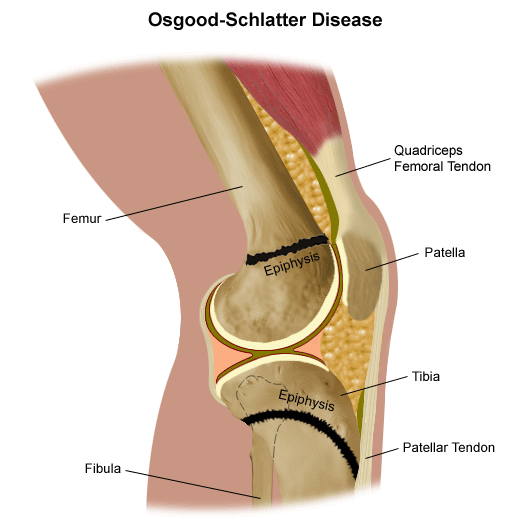Osgood-Schlatter disease/syndrome - symptoms and treatment

Osgood-Schlatter disease is a disorder of the epiphysis (growth plate) of the tibia, the long BONE in the lower leg (shin bone) that typically develops in athletically active adolescents. ADOLESCENCE is the period during which growth of the long bones is very rapid. The patellar TENDON stretches across the head of the tibia to attach at the top of the tibial tubercle. Athletic activities that extensively use the quadriceps MUSCLE in the thigh, such as basketball, place considerable pressure on the tendon insertion point. In Osgood-Schlatter disease, sometimes called jumper’s knee, tiny fragments of developing bone tissue pull away from the epiphysis and become embedded in the tendon. As these fragments, called avulsion fractures, mineralize they form a hard lump just below the patella (kneecap).
Symptoms of Osgood-Schlatter disease/syndrome
The main symptoms of Osgood-Schlatter disease, also called osteochondrosis, are a noticeable lump and PAIN in the area of the knee. Pain is often more intense when going up and down steps, running, and jumping. Osgood-Schlatter disease tends to affect girls at a younger age (10 to 12 years) than it affects boys (12 to 14 years). The doctor bases the diagnosis on the presentation of symptoms and the findings on X-RAY studies. The doctor may also conduct a bone scan when the Xray findings are unclear. However, diagnosis is usually straightforward.
Osgood-Schlatter Disease Treatment
Osgood-Schlatter disease is self-limiting; it goes away when growth in the tibia ceases. Ice to the area and NONSTEROIDAL ANTI-INFLAMMATORY DRUGS (NSAIDS) to relieve INFLAMMATION and pain are generally sufficient treatment. A physical therapist or sports medicine specialist can teach the child stretching exercises for the quadriceps and for the hamstrings, in the back of the thigh, to reduce pressure against the patellar tendon.
See also ATHLETIC INJURIES; PHYSICAL THERAPY.
Open discussion on the topic Osgood-Schlatter disease/syndrome - symptoms and treatment
Similar interests
- Nuovi Casino
- Casinos Not On Gamstop
- UK Casinos Not On Gamstop
- Casinos Not On Gamstop
- UK Casinos Not On Gamstop
- Casino Non Aams Italia
- Slot Sites Not On Gamstop
- Meilleur Casino En Ligne
- Non Gamstop Casino Sites UK
- Meilleur Casino En Ligne
- Casino En Ligne France
- Best Non Gamstop Casinos
- Casinos Not On Gamstop
- UK Casino Not On Gamstop
- Casinos Not Signed Up To Gamstop
- Best Slot Sites UK
- Non Gamstop Casino Sites UK
- Online Casinos Nederland
- Online Casinos Nederland
- Casinos Not On Gamstop
- Best New Uk Casinos Not On Gamstop
- Casino Non Aams
- Non Gamstop Casinos UK
- Migliori Siti Casino Non Aams
- Bitcoin Casinos